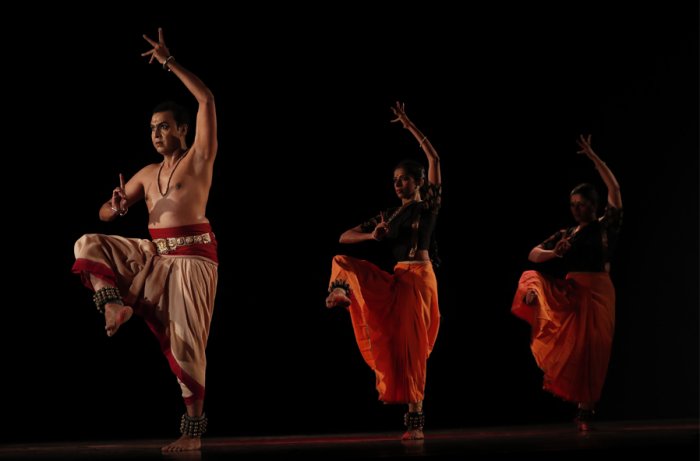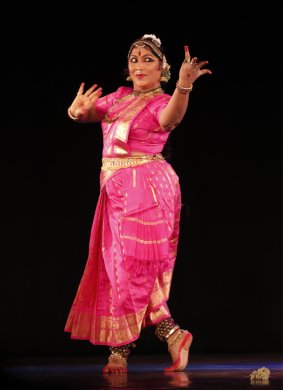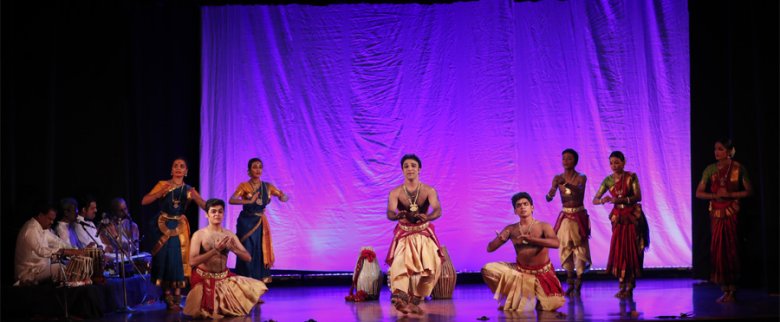
|   |

|   |
Natya Darshan performances - Day 2 - Sukanya Kumar e-mail: sukanya.kumar91@gmail.com Photos courtesy: Natya Darshan January 11, 2020 "The spire of life is like the seasons." Vaibhav Arekar presented 'Trayyanta,' his choreography based on philosophical truths. Comparing the avasthas of life to the changing seasons, the dancers, clad in black and orange, depicted the changing seasons to swara patterns and instrumental music.  Trayyanta To commence the second section, an explanation about the four tatvas was followed by Vaibhav presenting Bala, Taruna, Vridhdha stages of life in the spotlight while the dancers who had changed to full orange costume, moved in unison in the background. The dancers personifying 'mana - the mind,' 'budhdhi - intellect', 'chitta - memory,' and 'ahankara - ego' danced 'pulling' Vaibhav in different directions in a well-coordinated jathi with syllables of 'ta ham ta,' percussion designed by Prof. C.V. Chandrashekar and Kalishwaran Pillai. Vaibhav concluded with lines from the popular Nirvana Shatakam, in a calm composed circular walk 'winning over' the control of the tatvas. The music composed by veteran Guru C.V. Chandrashekhar added soul to the concise script by Pradnya Agasti.  Narthaki Nataraj Presenting the evergreen compositions and rare jathis of the Tanjore Quartet and Guru K.P. Kittappa Pillai, Narthaki Nataraj ushered in a sense of substance. Curating a margam based on Madhura Bhakti, her interpretation was centered on the concept of parabrahmam being the form taken by universal 'love.' Commencing with a composition of Karaikaal ammaiyar from the 2nd century, whose devotion forced the 'anadi' (one beyond relationships) Shivan to bind in maternal love and call her 'ammaiyae' i.e mother. Narthaki's sanchari on how Karaikkal ammaiyar saw both male and female forms in her lord was beautifully delineated. The PrabandaVarnam (6th to 8th century) was a perfect fit to the title of the conference 'Kadamba - the flowering path.' It was a 'kadamba' or garland of compositions by Alwars and Vaishnavaite saints of Tamil Nadu. "Even if the lines are from different composers, there is no differentiation in Bhakti," they said explaining the beauty of the lyrics. Padam 'Ivarkkum enakkum' by Vadalur Ramalinga Adigalar of the 19th century followed next. The portrayal of the line 'lock all the doors,' was presented with the appropriate panache. The next piece explored lines penned by Andal and Akka Mahadevi, who defied every restrain that society placed on them. "The body was their instrument through which their devotion is expressed," they described in the announcement. Ananthasree on nattuvangam, Kaushik Champakesan on vocal, Nagai Sriram on mridangam, Srilakshmi Ramani on violin, and Devraj on flute executed the aural section of the concept by Shakthi Bhaskar, providing the required support to Narthaki. Her finale was a poem penned by Narthaki herself, translated to English for the benefit of the cosmopolitan audience. While the beauty of Tamizh was lost in the translation of both the poem and the announcements, it was a powerful message questioning the fluidity of identity in arts that is beyond caste, religion, language, race and gender. The standing ovation that Narthaki received was proof of the reach that her 'traditional' innovative margam had. Narthaki's presentation was beyond the boundaries of identity, tradition enraptured in eternity.  Kalakshetra The audience waited in patient anticipation while the orchestra tuned and the background was changed to white. The finale by Kalakshetra was a nostalgic journey that gave a taste of Rukmini Devi Arundale's choreographies. Reviving sections of Ganga Pooja by Guhan and his clan from the Valmiki Ramayana (1960), the dancers presented a folk themed piece holding lamps to music composed by Mysore Vasudevacharya. The performance of the pooja was methodical. The Kurapaatu section from Kannappa Kuravanji (1962) came next, depicting the dance of praise during the coronation of Thinnappar, composed by Papanasam Sivan. The section from Choodamani Pradanam (1968) to music composed by Rajaram, son of Vasudevacharya, was set in ragamalika with tala, jathi and gati variations. The portrayal of the swans, bees, water birds, and lotus was picturesque. Scene of the Gandharva apsaras (1970), describing the battle between Rama and Ravana was a proof of the tasteful choices Rukmini Devi made as it avoided gory battle scenes and death on stage following the Natyashastra. Set in Suddha Dhanyasi, this composition by Bhagavatalu Seetarama Sharma was performed with grace using sparkling flowing drapes. "There is no art without education and no education without art," said Revathi Ramachandran, Director Kalakshetra, reiterating the philosophies of Rukmini Devi. Kabir bhajan from Shanti Sutra, directed and conceptualized by Revathi Ramachandran included some of the senior Kalakshetra dancers. Dancing with drums around a lamp in a sprightly manner to music by Sai Shankar, the dancers concluded the 19th Natya Darshan conference on a joyous note. Orchestra comprising of Hariprasad and Sai Shankar on vocal, K.P. Rakesh on nattuvangam, Anil Kumar on mridangam, Sashidhar on flute, and Srividya on veena gave a confident support to the young dancers. Sukanya Kumar is a practitioner of Bharatanatyam and Kathak genres trained under illustrious gurus. She is a Creative Culturist, and choreographer skilled in implementing electronic media technology in her productions to propagate social messages. She has a BSc in electronic media, MFA in Bharatanatyam, MBA in Educational management and MFA in Dance and Technology. |